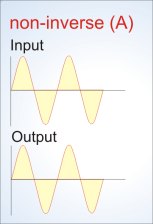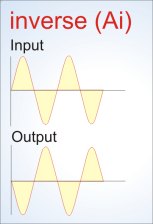EAV and bioresonance terminology
Bioresonance modes A and Ai
A bioresonance device typically has two operating modes: in-phase (A) and inverse (Ai). The abbreviations A/Ai have become established over the years. The A mode is also referred to as noninverse.

Bioresonance non inverse / in-phase Mode
Bioresonance noninverse / in-phase Mode
The mode A refers to a more nature-like transmission. The abbreviation (A) stands for All frequencies.
The output signal swings “up” or positively when the input signal swings to positive – and vice versa. This means that the output signal and the original input signal are aligned. This causes the signals to merge together and produce a constructive wave interference effect.
Perhaps an example can illustrate this: Imagine two pendulums, both swinging in the same direction at the same time. This mode is, for example, used in bioresonance to transfer test preparations that have balanced EAV values to the value of 50 in the standard EAV-resonance test.

Bioresonance inverse Mode (reversed output)
Bioresonance inverse Mode
In the mode Ai, the output is shifted in the opposite ”direction” to the inputs. The abbreviation (Ai) stands for All frequencies inverted. When a signal swings to positive (“up”) at the input, the output swings to the negative (“down”). Imagine two pendulums oscillating exactly in opposite directions at the same time. This mode is usually used in the energetic basic application of bioresonance, or for the transmission of test preparations that have balanced an EAV irritation in the so-called inverse EAV resonance test.
